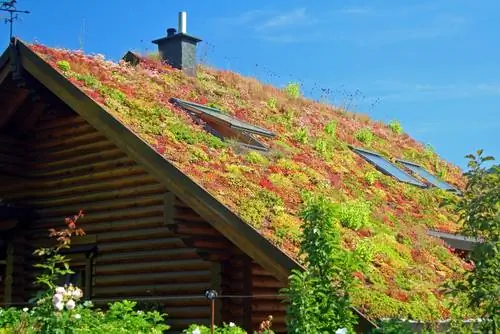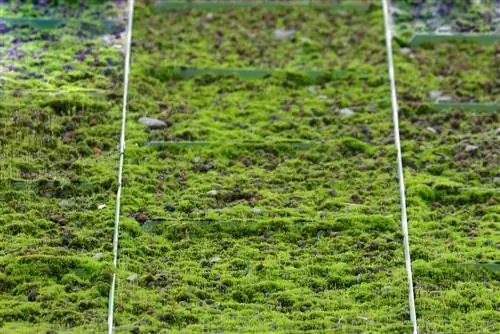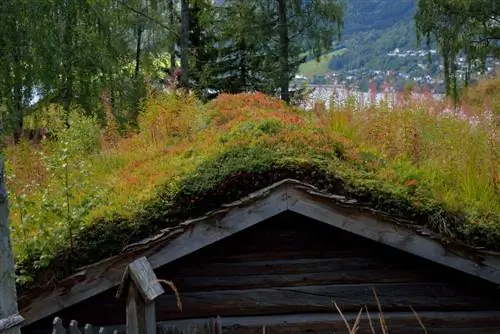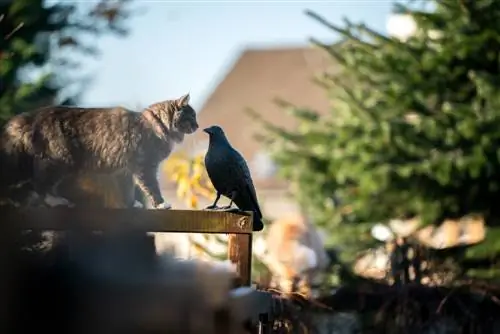- Author admin [email protected].
- Public 2023-12-16 16:46.
- Last modified 2025-06-01 06:02.
Put plants on the roof? What may initially sound like a crazy idea actually makes a lot of sense for a variety of reasons. A green roof provides food and a habitat for numerous animals, and the green layer also has an insulating effect and keeps the heating heat in the house in winter - and the heat outside in the summer. This article explains what you need to consider when planning a green roof and how you can ultimately create and maintain the green oasis.
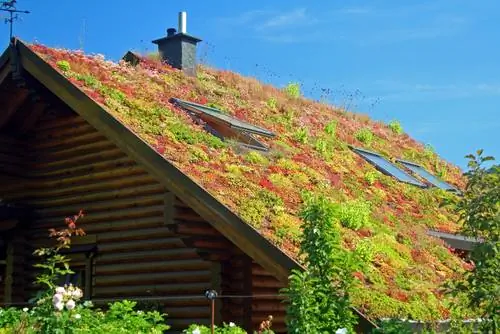
“Normality is a paved road. You can walk on it, but no flowers grow on it." (Vincent van Gogh)
What are the advantages of green roofs?
A green roof has a whole range of tangible benefits for both you and nature. Green roofs or even a roof garden offer a natural form of insulation that keeps the heat outside in the summer and the heat from the heating inside and the cold in the winter. In this way, costs for both heating and air conditioning can be saved, which in turn has a direct impact on the environment through the raw materials saved. Furthermore, the plants themselves also bind the climate-damaging carbon dioxide (CO2) and thus contribute to improving the climate balance.
A green roof also offers these advantages:
- increased sound insulation, as the greenery absorbs sound
- Plants as air filters: removal of fine dust and other air pollutants
- Roof is protected from weather and temperature fluctuations
- stored water evaporates and thus ensures cooling and pleasant humidity
- Retention of excess rainwater
- Improving the living and working environment
- Green roofs are often supported by funding
The best time to green your roof is spring or autumn.
Types of green roofs
In Germany, undeveloped areas are decreasing more and more, especially in times of acute housing shortage in the big cities. With a green roof you give nature back a piece of growth area and is therefore a kind of compensation. There are basically two types of green roofs.
Extensive greening
So-called extensive green roofs are carried out on roof surfaces that are otherwise unusable, such as those found on flat roofs such as carports and garages, but also on pitched roofs, on the roofs of factory halls or other buildings. Typical of this type of greening is the extremely thin substrate layer, which on average is no more than seven to twelve centimeters. Plants growing here must be adaptable, robust and undemanding as well as capable of regeneration. This means that after a long period of dryness or frost, the plants sprout again on their own. Another characteristic feature is the low maintenance effort: after installing the green roof, you basically have nothing left to do.
Intensive greening
With intensive green roofing, however, you essentially create a garden on your roof. Of course, such a roof garden only works on accessible roofs, after all, such a system is quite maintenance-intensive. The substrate layer applied here is more than 20 centimeters, which is why the selection of plants is much larger and you can also choose plants that are more demanding in terms of nutrient and water requirements.
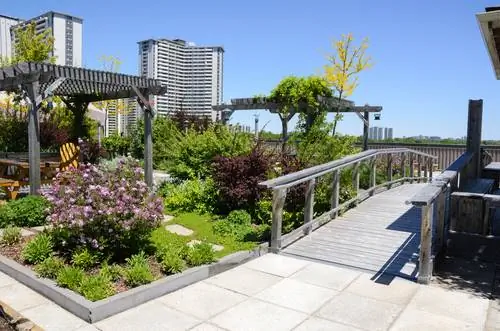
The intensive green roof is expensive and time-consuming - but creates a real roof garden
Planning a green roof
Before you get to work with high motivation and want to cover your roof with lots of green plants, you should first stop and spend some time planning. The following points in particular should be considered in advance:
- Static: Extensive greenery adds, on average, an additional 80 to 170 kilograms of weight per square meter to the roof. Not every roof can withstand this, which is why you should consult a structural engineer before starting construction.
- Roof constructions: The roof construction itself also has an influence on the type of green roof. While both extensive and intensive greening is possible on a warm roof, you can only create extensive forms on a so-called cold roof.
- Roof pitch: Creating a green area on a flat roof is no problem, even slopes of up to around 30 degrees can be planted. However, fall protection is required for gradients of 15 degrees or more.
- Root protection: The roof also needs sealing and root protection to prevent damage.
- Irrigation and drainage: A drainage layer makes sense for two reasons. On the one hand, this directs excess rainwater straight to the drain, and on the other hand, it supplies the plants with valuable moisture.
Basically, it makes sense to hire a specialist company for larger projects - where more is planned than just adding some potting soil and a few sedum sprouts to the garage roof. This is especially true when planning a roof garden.
Greening a flat roof or garage - you have these options
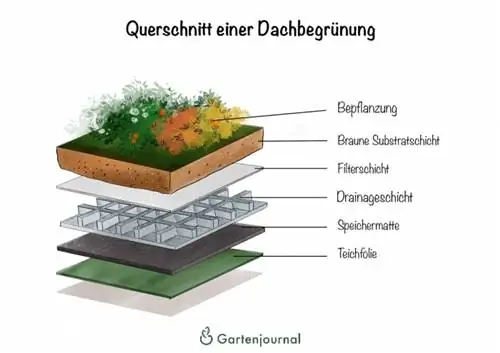
Every green roof is made up of several layers:
- Fleece: This lowest layer separates the actual roof from the green roof.
- Protective film: Place a waterproof (root) protective film on top, which has a durability guarantee of at least 20 years.
- Storage mat and drainage layer: Both are intended to drain away and store excess rainwater.
- Fleece: Another fleece serves as a filter, otherwise the drainage would become clogged over time with fine substrate particles.
Only now apply the layer of soil, which usually consists of a substrate specially mixed for green roofs. This contains a high proportion of light materials such as pumice, lava or brick chippings and only around ten to 15 percent humus. Finally, the planting takes place.
The following article shows how you can easily green a flat roof - such as that of a shed or garage - using potting soil and sedum sprouts. But be careful: This approach is only recommended for a flat roof on a garage or similar, but not for a residential building!

Planting options
Once the roof is waterproof and the various layers have been applied, you can now plant the species you want. When choosing, pay attention to the fact that certain plants require a minimum substrate thickness. You have different options for getting the plants on the roof. Which one you choose depends, among other things, on how quickly you want the roof to be greened. As a rule, the growth phase is completed after about three to four weeks, during which the plants generally require more water. Only after they have taken root can they survive longer dry periods.
Excursus
When is the best time to plant?
Therefore, the months between March to the end of June and from the beginning of September to November offer the best growing conditions for the plants, after all, high heat also means a lack of water. Therefore, you should only grow roof plants during the summer months if you can water them intensively at the same time.
Plants
It involves a bit of work, but is very efficient - after all, this is how the plants grow fastest - planting them by hand in the substrate. In this way, you also have control over the actual design and distribution of the plants. For extensive greening of Sedum species, plan around 15 to 20 plants per square meter. These should have a ball size of around five to six centimeters (so-called “flat ball perennials”). After some time, the individually planted plants grow together and finally form a closed area. If gaps appear in this area, you can still replant or sow.
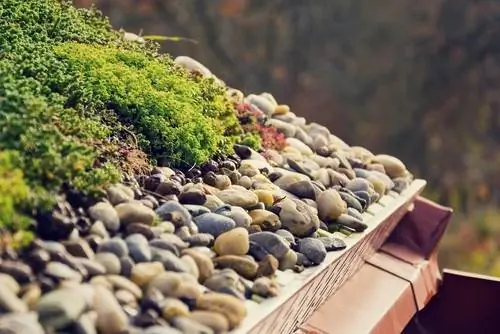
Various types of sedum are usually used for roof planting
Sprout planting
Of course it's easier and quicker with sedum sprouts, which you simply scatter and then grow on their own. The disadvantage of this method, however, is that it can take up to a year for the roof to be completely greened. Plan on around 80 to 100 grams of sprouts per square meter of planting area. You can purchase these from specialist retailers.
Sowing
If you only want to spend a small amount of money, special seed mixes may be the right solution for you. However, you need patience for this, because it can take one to two years for the seeds to germinate and the plants to grow - or even several years until they are completely green. In addition, unwanted grasses can settle on the bare substrate area due to aerial insemination, which you have to remove regularly in the first few months.
vegetation mat
Green roofing works particularly quickly with a vegetation mat, which is basically a type of roll mat that has already been planted. The plants have already grown into a special structure made of fleece and substrate and just need to be applied, like with rolled turf. Vegetation mats are particularly recommended for steep or sloping roofs. Nevertheless, apply a thin layer of substrate about four to six centimeters thick under the mat so that the plants can grow better.
Suitable plants
Depending on the type of green roof desired and the thickness of the substrate applied, plant species of different heights can be used. The most important condition for all species, however, is that they are very robust against weather conditions such as wind, cold and rain - and also tolerate drought well.
- Low substrate structure (up to five centimeters): Mosses, Sedum species
- Low substrate structure (five to seven centimeters): low herbs such as chives, wild marjoram, meadow daisy, chartreuse, chamomile
- Higher substrate structure (15 centimeters): taller flowering plants and grasses
The following table provides an overview of some of the most important plant species for green roofs.
| Art | Latin name | Growth height | Flower color | Flowering time |
|---|---|---|---|---|
| Camomile | Anthemis tinctoria | 20 to 50 centimeters | yellow | June to September |
| Field thyme | Thymus pulegioides | 5 to 30 centimeters | purple | June to October |
| Rock Carnation | Petrorhagia saxifraga | 10 to 25 centimeters | white-pink | June to September |
| Knapweed | Centaura scabiosa | 30 to 100 centimeters | purple | June to September |
| Common soapwort | Saponaria officinalis | 30 to 80 centimeters | white-pink | June to September |
| Heather Carnation | Dianthus deltoides | 10 to 30 centimeters | red | June to September |
| Carthusian carnation | Dianthus carthusianorum | 15 to 40 centimeters | red | June to September |
| Little Meadow Button | Sanguisorba minor | 30 to 60 centimeters | reddish | May to August |
| Little Hawkweed | Hieracium pilosella | 5 to 25 centimeters | yellow | May to October |
| Little soapwort | Saponaria ocymoides | 5 to 6 centimeters | red | May to June |
| Ballbellflower | Campanula glomerata | 30 to 60 centimeters | blue violet | June to September |
| Peach-leaved Bellflower | Campanula persicifolia | 30 to 80 centimeters | blue | June to August |
| Round-leaved bellflower | Campanula rotundifolia | 10 to 40 centimeters | light blue | June to September |
| Yarrow | Achillea millefolium | 15 to 50 centimeters | white | June to October |
| Chives | Allium schoenoprasum | 10 to 40 centimeters | pink | June to August |
| Silver cinquefoil | Potentilla argentea | 10 to 40 centimeters | yellow | June to August |
| Storksbill | Geranium robertianum | 20 to 50 centimeters | pink | May to October |
| Wild strawberry | Fragaria vesca | 5 to 20 centimeters | white | April to June |
| White Stonecrop | Sedum album | 8 to 20 centimeters | white | June to July |
| Meadow daisy | Chrysanthemum leucanthemum | 20 to 50 centimeters | white | June to October |
| Wild Thyme | Thymus serpyllum | 5 to 15 centimeters | purple | June to October |
| Wild marjoram | Origanum vulgare | 20 to 60 centimeters | light purple | July to October |
Tip
If, on the other hand, you are aiming for intensive greenery with higher substrate layers, you are of course much more free in your selection and can use species that would also grow in a normal garden.
Proper care of the green roof
With extensive green roofs, once the plants have taken root, you don't have much to do. However, you should water regularly in the first four weeks after planting to promote root growth. Depending on the temperature and duration of sunshine, you can use the watering can up to four times a week. You then weed about once or twice a year and use this opportunity to primarily remove germinated tree seeds, such as birch trees, as these should not grow on the roof. The roots grow quickly into the drainage layer and can destroy the roof as they grow.
Funding programs and costs
A green roof is not a cheap affair, although the costs involved vary greatly depending on the type of greenery, the size of the area and other factors. A roof that has been planted by a specialist company is of course a lot more expensive than one that you have planted on your own. For the latter, plan around EUR 20 to 40 per square meter of planting area, provided it is an extensively planted green roof. Intensive greening costs about twice as much.
Fortunately, you can recoup at least some of the costs, as some municipalities grant grants of between ten and 20 EUR per square meter for such a project or cover a percentage of your costs. Funding programs from the Kreditanst alt für Wiederaufbau (KfW) can be used, for example, in the course of building renovations, with green roofs also being financed through the “Modernize Living Spaces” program. Another savings opportunity arises from recognizing roof greening as a desealing measure - many municipalities reward this with reduced wastewater fees.
Frequently asked questions
Does a green roof prevent the house from heating up in summer?
In fact, a green roof has an insulating effect and keeps the heat out in summer. So it's cooler inside the house.
Does the green roof also have a heat-insulating effect?
While the summer heat stays outside, the green roof keeps the heat in during the cold season. The heat-insulating effect of a green roof can even be calculated based on the building materials, the amount of soil and plant mass. However, this is a task for experts such as architects or civil engineers.
Can I also plant and harvest herbs on the roof?
Herbs such as oregano, thyme or chives are great to use for green roofs. They are frost hardy, cope well with sun, are easy to care for and don't need a lot of water.
Why do the plants on the roof suddenly turn red?
If the plants on the roof are no longer a nice, juicy green but suddenly turn reddish or brownish, there is probably a nutrient deficiency. In general, nutrient-poor substrate is used for green roofs, so fertilization is necessary from time to time.
Which plants are particularly suitable for bees and butterflies?
Many of the plants suitable for a green roof are valuable insect pastures anyway, so that bees, butterflies, bumblebees and other winged creatures can enjoy plenty of food. In this context, it is of course important that the flowering period of the plants does not only last a few weeks, but if possible extends from spring to late autumn.
How many plants do you have to plan for per square meter?
If you want to plant perennials and various types of sedum, you should plan around 15 to 20 plants per square meter. However, the exact number depends on the species and varieties selected, as they have very different requirements in terms of planting distances. You can also add greenery to a roof, for example by spreading flower seeds on it. A colorful wildflower meadow on the roof also has something.
How much soil does a green roof need? And which soil should you use?
How much soil you need depends primarily on how thick the layer should be. For shallow-rooted plants, a layer of substrate approximately six centimeters thick is usually sufficient. For this, plan around 60 liters of soil per square meter of roof area. A nutrient-poor substrate is usually used for this.
Does such a green roof also have disadvantages?
In principle, such a green roof has no disadvantages, except perhaps the occasional maintenance effort. However, you have to be careful with the building statics, because not every building can tolerate the additional load on the roof. Therefore, before starting the construction project, have the statics checked by a specialist and take the opportunity to pay a visit to the local building authority: Depending on the project, you may need a building permit for your project.
Tip
Many low bulbous flowers are also suitable for greening a roof. Daffodils, hyacinths, tulips, dwarf irises, crocuses and pushkinias bloom in spring, creating a colorful portrait.

